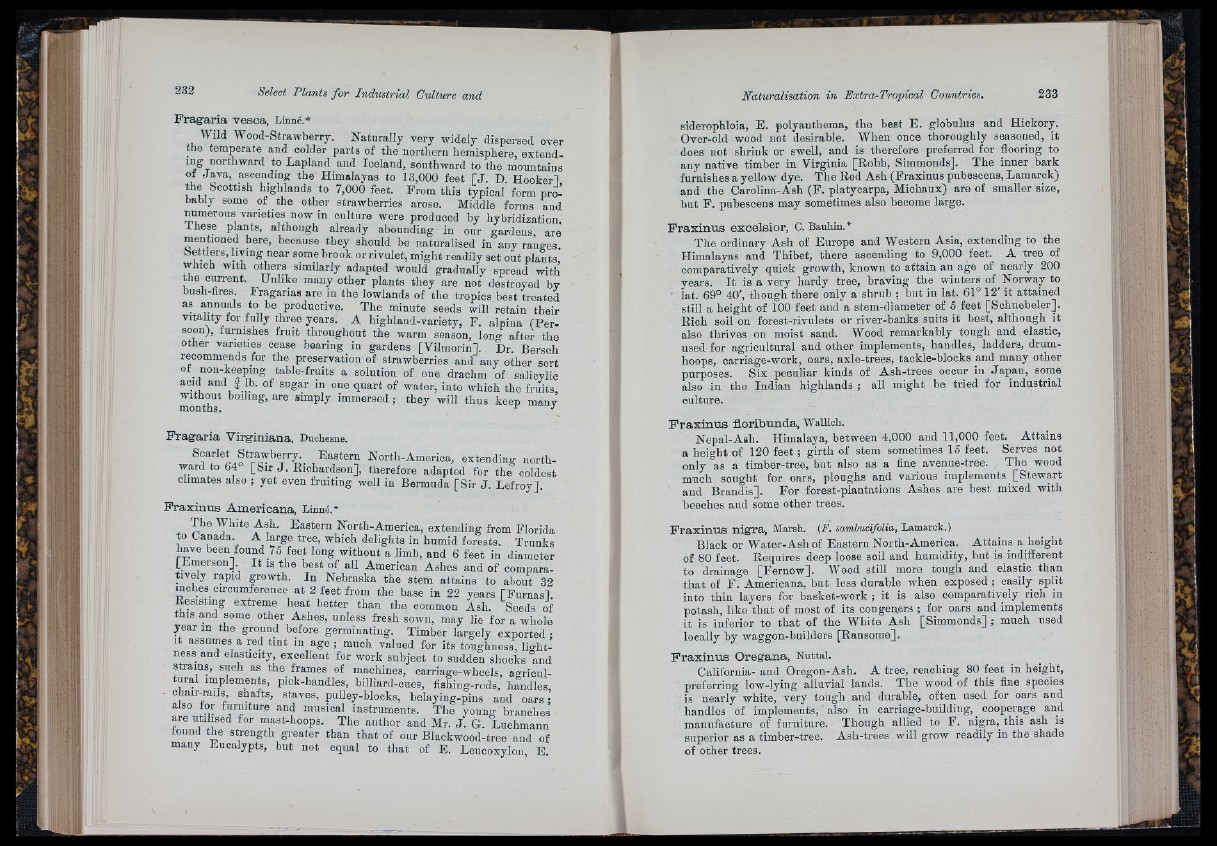
232 Select Plants fo r Industrial Culture and Naturalisatiem in Extra-Tropical Countries. 233
I
k
I■
fr‘1’
r .
Fragaria vesoa, Linné.*
Wild Wood-Strawberry. Naturally very widely dispersed over
the temperate and colder parts of the northern hemisphere, extending
northward to Lapland and Iceland, southward to the mountains
of Jav a , ascending t le Himalayas to 13,000 feet [ J . D. Hookeri
the Scottish highlands to 7,000 feet. From this typical form pro-’
bably some of the other strawberries arose. Middle forms and
numerous varieties now in culture were produced by hybridization.
These plants, although already abounding in our gardens, are
mentioned here, because they should be naturalised in any ranges
Settlers, living near some brook or rivulet, might readily set out plants,
which with others similarly adapted would gradually spread with
ffle current. Unlike many other plants they are not destroyed by
bush-fires. Fragarias are in the lowlands of the tropics best treated
as annuals to be productive. The minute seeds will retain their
vitality for fully three years. A highland-variety, F. alpina (P e rsoon),
lurnishes fruit throughout the warm season, lonu after the
other varieties cease bearing in gardens [Vilmorin]. Dr. Bersch
recommends for the preservation of strawberries and any other sort
of non-keeping table-fruits a solution of one drachm of salicylic
acid and j lb. of sugar in one quart of water, into which the fruits
months' immersed ; they will thus keep many
Fragaria Virginiana, Duchesne.
North-Ameriea, extending northward
to 64 [S ir J . Richardson], therefore adapted for the coldest
climates also ; yet even fruiting well in Bermuda [S ir J . Lefroy].
Fraxinus Americana, Linné.»
The White Ash. Eastern North-America, extending from Florida
to Canada. A large tree, which delights in humid forests. Trunks
have been found 75 feet long without a limb, and 6 feet in diameter
[Emerson] I t is the best of all American Ashes aud of comparatively
rapid growth. In Nebraska the stem attains to about 32
mches circumference a t 2 feet from the base in 22 years [Fu rn a si
Resisting extreme heat better than the common Ash. Seeds of
this and some other Ashes, unless fresh sown, may lie for a whole
year in the ground before germinating. Timber largely exported :
it assumes a red tin t in age ; much valued for its toughness, lig h tness
and elasticity excellent for work subject to sudden shocks and
strains, such as the frames of machines, carriage-wheels, agricultural
implements, pick-handles, billiard-cues, fishing-rods, hL d le s ,
c air-raiis, shafts, staves, pulley-blocks, belaying-pins aud oars ;
also for furniture and musical instruments. The young branches
are utilised for mast-hoops. The author aud Mr. J . G. Luehmann
found the strength greater than th a t of our Blackwood-tree and of
many Eucalypts, but not equal to th a t of E. Leucoxylon E
siderophloia, E. polyanthema, the best E. globulus and Hickory.
Over-old wood not desirable. When once thoroughly seasoned, it
does not shrink or swell, and is tlierefore preferred for flooring to
any native timber in Virginia [Robb, Simmonds]. The inner bark
furnishes a yellow dye. The Red Ash (Fraxinus pubescens, Lamarck)
and the Carolina-Ash (F. platyoarpa, Michaux) are of smaller size,
but F. pubescens may sometimes also become large.
Fraxinus excelsior, C. Bauhin.*
The ordinary Ash of Europe and Western Asia, extending to the
Himalayas and Thibet, there ascending to 9,000 feet. A tree of
comparatively quick growth, known to attain an age of nearly 200
years. I t is a very hardy tree, braving the winters of Norway to
' lat. 69° 40', though there only a shrub ; but in lat. 61° 12' it attained
still a height of 100 feet and a stem-diameter of 5 feet [Schuebeler].
Rich soil on forest-rivulets or river-banks suits it best, although it
also thrives on moist sand. Wood remarkably tough and elastic,
used for agricultural and other implements, handles, ladders, drum-
hoops, carriage-work, oars, axle-trees, tackle-bloeks and many other
purposes. Six peculiar kinds of Ash-trees occur in Jap an , some
also in the Indian highlands ; all might be tried for industrial
culture.
Praxintts fioribunda, Wallich.
Nepal-Ash. Himalaya, between 4,000 and 11,000 feet. Attains
a height of 120 feet ; girth of stem sometimes 15 feet. Serves not
only as a timber-tree, but also as a fine avenue-tree. The wood
much sought for oars, ploughs and various implements [Stewart
and Brandis]. F o r forest-plantations Ashes are best mixed with
beeches and some other trees.
Fraxinus nigra, Marsh. {F. sambudfoUa, Lamarck.)
Black or Wate r-Ashof Eastern North-America. Attains a height
of 80 feet. Requires deep loose soil and humidity, but is indifferent
to drainage [Fernow]. Wood still more tough and elastic than
th a t of F . Americana, but less durable when exposed ; easily split
into thin layers for basket-work ; it is also comparatively ricli in
potash, like th a t of most of its congeners ; for oars and implements
it is inferior to th a t of the White Ash [Simmonds] ; much used
locally by waggon-builders [Bansome].
Fraxinus Oregana, Nuttal.
California- and Oregon-Ash. A tree, reaching 80 feet in height,
preferring low-lying alluvial lands. The wood of this fine species
is nearly white, very tough and durable, often used for oars and
handles of implements, also in carriage-building, cooperage aud
manufacture of furniture. Though allied to F . nigra,_ this ash is
superior as a timber-tree. Ash-trees will grow readily in the shade
of other trees.
' ' '■'!
'iifr
:
■i : ■
; ’